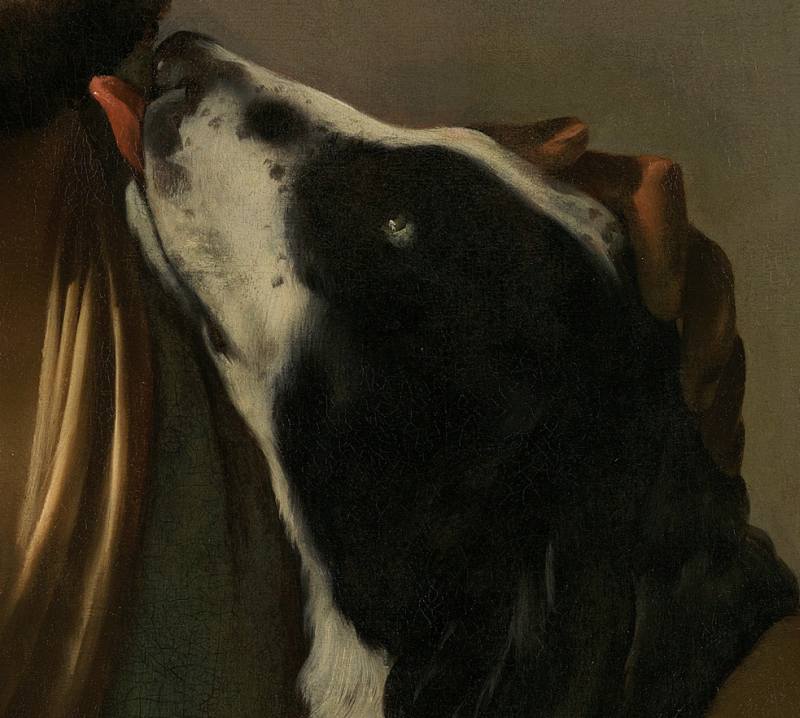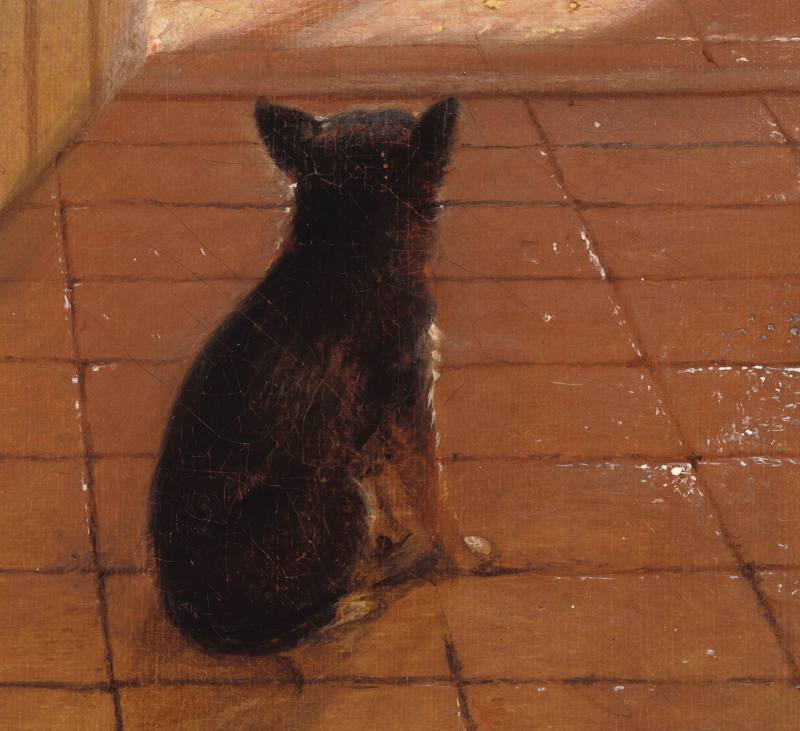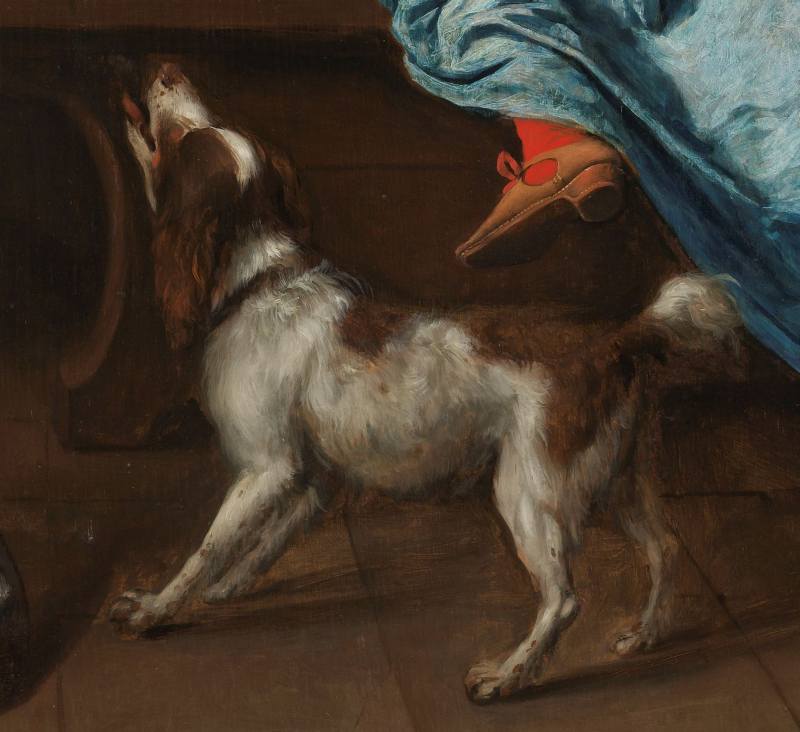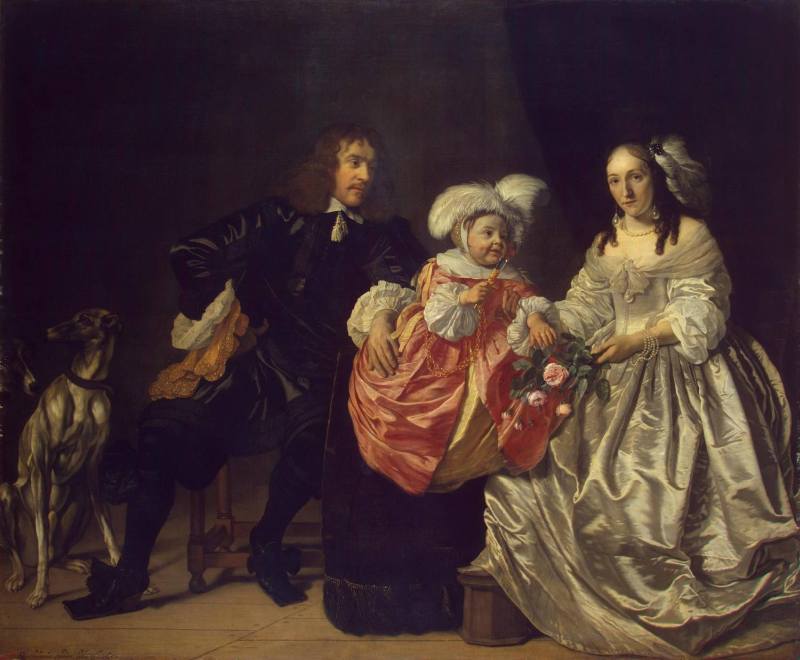Una muy disfrutable y extremadamente productiva visita a Bélgica y Países Bajos del año 2013 es la base para este post en el que os dejo una selección de obras de artistas neerlandeses y los correspondientes detalles con representaciones caninas.
A very enjoyable and extremely productive visit to Belgium and the Netherlands in 2013 is the basis for this post in which I leave you with a selection of works by Dutch artists and the corresponding details with canine representations.
_______________________________________________________________
Más perros neerlandeses / More Dutch Dogs
Hendrick Jansz. ter Brugghen
(Deventer, Nederland / Países Bajos / Netherlands, c.1588 - Utrecht, 1629)
"De rijke man en de arme Lazarus / La parábola del hombre rico y el pobre Lázaro /
The parable of the rich man and poor Lazarus, Lucas 16:19-13"
Óleo sobre lienzo / oil on canvas, 160 x 207,5 cm., 1625
Centraal Museum (Utrecht, Nederland / Países Bajos / Netherlands). Wikimedia Commons
Hendrick Jansz ter Brugghen (o Terbrugghen) fue un pintor holandés de escenas de género y temas religiosos, nacido hacia 1588.
Fue uno de los seguidores holandeses de Caravaggio, los llamados "Caravaggistas de Utrecht". Junto con Gerrit van Hondhorst y Dirck van Baburen, Ter Brugghen fue uno de los pintores neerlandeses más importantes influidos por Caravaggio.
No se han identificado referencias a ter Brugghen escritas durante su vida. Su padre, Jan Egbertsz ter Brugghen, originario de Overijssel, se trasladó a Utrecht, donde fue nombrado secretario de la Corte de Utrecht por el príncipe de Orange, Guillermo el Silencioso.
"De rijke man en de arme Lazarus / La parábola del hombre rico y el pobre Lázaro /
The parable of the rich man and poor Lazarus, Lucas 16:19-13" (detalle / detail)
"De rijke man en de arme Lazarus / La parábola del hombre rico y el pobre Lázaro /
The parable of the rich man and poor Lazarus, Lucas 16:19-13" (detalle / detail)
La primera referencia breve al pintor se encuentra en Het Gulden Cabinet (1661) de Cornelis de Bie, donde se le llama erróneamente Verbrugghen.
Cornelis de Bie, en su "Spiegel vande Verdrayde Werelt" (1708), y Arnold Houbraken, en su "De Groote Schouburgh" (1718-1721), elaboraron biografías en las que repetían las afirmaciones de Richard (hijo de Hendrick) de que el pintor conoció a Rubens en Roma y también trabajó en Nápoles. Había un cadete del mismo nombre sirviendo en el ejército de Ernst Casimir de Nassau-Dietz en la primavera de 1607, y por esta razón, se cree que ter Brugghen estuvo en Italia, pero sólo en ese año, y no como se creía anteriormente en 1604 (como se deducía de la inscripción en el grabado de Bodart). Esto significaría, sin duda, que nunca conoció a Caravaggio en Roma; este artista había huido de Roma acusado de asesinato en 1606. Sin embargo, es seguro que fue el único pintor holandés en Roma durante la vida de Caravaggio.
Murió en 1629.
"Jacob reprochando a Labán / Jacob Reproaching Laban"
Óleo sobre lienzo / oil on canvas, 123,5 x 157,5 cm., 1628
Wallraf–Richartz Museum (Köln, Deutschland / Colonia, Alemania / Cologne, Germany). Wikimedia Commons
"La vocación de San Mateo / The Calling of St Matthew"
Óleo sobre lienzo / oil on canvas, 152 x 195 cm., 1620
Musée Malraux (MuMa), Musée des Beaux-Arts (Le Havre, Francia / France). GAP
Hendrick Jansz ter Brugghen (or Terbrugghen) was a Dutch painter of genre scenes and religious subjects, born c.1588.
He was one of the Dutch followers of Caravaggio – the so-called Utrecht Caravaggisti. Along with Gerrit van Hondhorst and Dirck van Baburen, Ter Brugghen was one of the most important Dutch painters to have been influenced by Caravaggio.
No references to Ter Brugghen written during his life have been identified. His father Jan Egbertsz ter Brugghen, originally from Overijssel, had moved to Utrecht, where he was appointed secretary to the Court of Utrecht by the Prince of Orange, William the Silent.
"La vocación de San Mateo / The Calling of St Matthew" (detalle / detail)
"Un sonriente Bravo (mercenario) con su perro / A Laughing Bravo (mercenary) With His Dog"
Óleo sobre lienzo / oil on canvas, 83,2 x 68,5 cm., 1628
Colección Hehenbuchau, en préstamo permanenete Liechtenstein /
Hohenbuchau Collection, a on permanent loan to Liechtenstein.
The Princely Collections (Wien, Österreich / Viena, Austria / Vienna). Wikimedia Commons
The earliest brief reference to the painter is in Het Gulden Cabinet (1661) of Cornelis de Bie, where he is mistakenly referred to as Verbrugghen.
Cornelis de Bie, in his Spiegel vande Verdrayde Werelt (1708), and Arnold Houbraken, in his De Groote Schouburgh (1718-1721), produced biographies where they repeated Richard's claims (Richard was the son of Hendrick) that the painter met Rubens in Rome and also worked in Naples. There was a cadet of the same name serving in the army of Ernst Casimir of Nassau-Dietz in the spring of 1607, and for this reason, Ter Brugghen is thought to have been in Italy, but only in that year, rather than as previously believed in 1604 (inferred as it was from the inscription on the Bodart print). This would certainly mean that he never met Caravaggio in Rome; that artist had fled Rome on a murder charge in 1606. However, it is certain that he was the only Dutch painter in Rome during Caravaggio's lifetime.
He died in 1629.
"Un sonriente Bravo... / A Laughing Bravo..." (detalle / detail)
_____________________________________________________________________Pieter de Hooch
(Rotterdam, Nederland / Róterdam, Países Bajos / Netherlands, 1629 -
Ámsterdam, 1684)
"Hombre entregando una carta a una mujer en el vestíbulo de una casa /
Man Handing a Letter to a Woman in the Entrance Hall of a House"
Óleo sobre lienzo / oil on canvas, h 68cm × w 59cm., 1670
Rijksmuseum (Amsterdam, Nederland / Países Bajos / Netherlands)
"Hombre entregando una carta... / Man Handing a Letter..." (detalle / detail)
"Een moeder die het haar van haar kind reinigt, bekend als ‘Moedertaak’ /
Una madre despiojando a su niña, conocido como 'El deber de una madre' /
A Mother Delousing her Child's Hair, known as ‘A Mother's Duty’"
Óleo sobre lienzo / oil on canvas, 52,5 x 61 cm., 1658-60.
Rijksmuseum (Amsterdam, Nederland / Países Bajos / Netherlands). Wikimedia Commons
"Een moeder... / Una madre... / A Mother..." (detalle / detail)
"La sala del concejo del ayuntamiento de Ámsterdam /
Interior of the Council Chamber of Amsterdam Town Hall"
Óleo sobre lienzo / oil on canvas, 112,5 x 99 cm., 1663-65
Museo Thyssen-Bornemisza (Madrid, España / Spain)
"La sala del concejo... / Interior of the Council Chamber..." (detalle / detail)
Pieter de Hooch en "El Hurgador" / in this blog: [Aniversarios (XLVIII)]
_____________________________________________________________________
Jan Havickszoon Steen
(Leiden, Nederland / Países Bajos / Netherlands, c. 1626 - 1679)
"Kinderen leren een poes dansen, bekend als ‘De dansles’ /
Niños enseñando a bailar a un gato, conocido como 'La lección de baile' /
Children Teaching a Cat to Dance, Known as ‘The Dancing Lesson’"
Óleo sobre panel / oil on panel, 68,5 × 59 cm., 1660-9
Rijksmuseum (Amsterdam, Nederland / Países Bajos / Netherlands)
"De dansles... / La lección de baile / The Dancing Lesson’" (detalle / detail)
"Het vrolijke huisgezin / La alegre familia / The Merry Family"
Óleo sobre lienzo / oil on canvas, 110,5 × 141cm., 1668
Rijksmuseum (Amsterdam, Nederland / Países Bajos / Netherlands)
"Het vrolijke huisgezin / La alegre familia / The Merry Family" (detalle / detail)
"Soo gewonne, soo verteert / Fácil llega, fácil se va / Easy Come, Easy Go"
Óleo sobre lienzo / oil on canvas, 1661
Museum Boijmans van Beuningen (Rotterdam, Nederland / Róterdam, Países Bajos / Netherlands)
"Soo gewonne, soo verteert / Fácil llega, fácil se va / Easy Come, Easy Go" (detalle / detail)
Jan Steen en "El Hurgador" / in this blog: [Arte y Humor (XI, Anexo)], [Arte y odontología (III)]
_____________________________________________________________________
Bartholomeus van der Helst
(Haarlem, Nederland / Países Bajos / Netherlands, 1613 - Ámsterdam, 1670)
"Schutters van wijk VIII in Amsterdam onder leiding van kapitein /
La compañía de milicias del distrito VIII a las órdenes del Capitán /
Militia Company of District VIII under the Command of Captain Roelof Bicker"
Óleo sobre lienzo / oil on canvas, 235 × 750 cm., c.1640-1643
Rijksmuseum (Amsterdam, Nederland / Países Bajos / Netherlands)
"Schutters van wijk VIII... / La compañía de milicias del distrito VIII... /
Militia Company of District VIII..." (detalle / detail)
"De overlieden van de Handboogdoelen /
De vier overlieden van de Handboog- (St Sebastiaan) doelen te Amsterdam"
Los jefes de la Casa de la Guardia Cívica de Longbow
The headmen of the Longbow Civic Guard House"
Óleo sobre lienzo / oil on canvas, 183 x 268 cm., 1653
Amsterdam Museum (Nederland / Países Bajos / Netherlands)
"De overlieden... / Los jefes... / The headmen..." (detalle / detail)
"Twee regenten en twee regentessen van het Spinhuis /
Dos gobernadores y dos gobernadoras de la Spinhuis /
Two Governors and two Lady Governors of the Spinhuis"
Óleo sobre lienzo / oil on canvas, 219 x 305 cm., 1650
Amsterdam Museum (Nederland / Países Bajos / Netherlands)
"Twee regenten... / Dos gobernadores... / Two Governors..." (detalle / detail)
"Retrato de familia (Pieter Lucaszn van de Venne con Anna de Carpentier and su niña) /
Family Portrait (Pieter Lucaszn van de Venne with Anna de Carpentier and Child)"
Óleo sobre lienzo / oil on canvas, 187,5 x 226,5., 1652
Museo Hermitage (Санкт-Петербург, Россия / San Petersburgo, Rusia / St. Petersburg, Russia)
"Retrato de familia / Family Portrait" (detalle / detail)
"Retrato de una familia / Portrait of a Family", óleo sobre lienzo / oil on canvas, 235 x 345 cm., 1647 (1652)
Museo Hermitage (Санкт-Петербург, Россия / San Petersburgo, Rusia / St. Petersburg, Russia)
"Retrato de una familia / Portrait of a Family" (detalle / detail)
"Retrato de Jan Jacobs. Hinlopen y Lucía Wijbrants con una vista a su izquierda mostrando a una nodriza con un niño /
Portrait of Jan Jacobsz. Hinlopen (1626-1666) and Lucia Wijbrants (1638-1719) with to the left a vista showing a wet nurse and child"
Óleo / oil, 1666. Colección privada / Private Collection. Wikimedia Commons
"Retrato de Jan Jacobs. Hinlopen... / Portrait of Jan Jacobsz. Hinlopen..." (detalle / detail)
Bartholomeus van der Helst en "El Hurgador" / in this blog: [Carne y huesos (II)]
_____________________________________________________________________
Abraham Lambertsz. van den Tempel
(Leeuwarden, Nederland / Países Bajos, Netherlands, c.1622 - Ámsterdam, 1672)
David Leeuw met zijn gezin / con su familia / with his Family"
Óleo sobre lienzo / oil on canvas, 190 × 200 cm., 1671
Rijksmuseum (Amsterdam, Nederland / Países Bajos / Netherlands)
Abraham van den Tempel fue un pintor holandés del Siglo de Oro, nacido en 1622 en Leeuwarden.
Probablemente aprendió a pintar con su padre, también pintor, pero que murió cuando él era aún muy joven, en 1636. Ese mismo año se trasladó a Ámsterdam, donde permaneció hasta 1647, cuando se mudó a Leiden. Según Houbraken era hijo de un predicador menonita de Leeuwarden que era un respetado profesor de arte. Su padre era Lambert Jacobsz (o Jacobszoon), que había enseñado en su juventud a Govert Flinck y Jacob Adriaensz Backer, ambos artistas de familias menonitas. Abraham adoptó el nombre de Tempel porque, cuando estudiaba en Leiden, vivía en una casa con un relieve de un Tempel en la clave. Fue alumno de Jacob Backer y estudió matemáticas en la Universidad de Leiden. Tuvo un gran éxito con el ayuntamiento de Leiden obteniendo varios generosos encargos, entre ellos una serie de tres grandes cuadros alegóricos a la industria textil de Leiden para el Salón de la Tela que aún hoy cuelgan en su lugar original en el Stedelijk Museum De Lakenhal.
En 1657 se convirtió en maestro de la Cofradía de San Lucas y en 1659 en maestro de obras. En 1660 regresó a Áms
terdam.
Murió en 1672.
David Leeuw met zijn gezin / con su familia / with his Family" (detalle / detail)
"Retrato de / Portrait of Jacquemijna Le Pla", óleo sobre lienzo / oil on canvas, 114,9 x 92,3 cm., c.1666
Colección privada / Private Collection. Wikimedia Commons
Abraham van den Tempel was a Dutch Golden Age painter, born in 1622 in Leeuwarden.
He probably learned painting from his father, also a painter, but who died when he was still quite young, in 1636. That is the same year that he moved to Amsterdam, where he stayed until 1647, whereupon he moved to Leiden. According to Houbraken he was the son of a Mennonite preacher in Leeuwarden who was a respected art teacher. His father was Lambert Jacobsz (or Jacobszoon), who had taught Govert Flinck and Jacob Adriaensz Backer in their youth, both of whom were artists from Mennonite families. Abraham took the name Tempel because when he studied in Leiden, he lived in a house there with a relief of a Tempel in the keystone. He became a pupil of Jacob Backer, and studied mathematics at Leiden University. He met with great success with the Leiden city council, earning several generous commissions, including a series of three large allegorical paintings on the cloth industry of Leiden for the Cloth Hall which still hang in their original place today in the Stedelijk Museum De Lakenhal.
He became master of the Guild of St. Luke in 1657 and in 1659 he was chartermaster. In 1660 he returned to Amsterdam.
He died in 1672.
"Retrato de / Portrait of Jacquemijna Le Pla" (detalle / detail)
"Portret van Albertine Agnes, Prinses van Oranje, met haar drie kinderen /
Retrato de Albertine Agnes de Nassau con sus tres niños /
Portrait of Albertine Agnes van Nassau With Her Three Children"
Óleo sobre lienzo / oil on canvas, 140 x 192 cm., 1668
Fries Museum (Leeuwarden, Nederland / Países Bajos / Netherlands)
"Portret van Albertine Agnes... / Retrato de Albertine Agnes... / Portrait of Albertine Agnes..." (detalle / detail)






































Este comentario ha sido eliminado por el autor.
ResponderEliminarHe vuelto a tu maravilloso blog (era seguidora y no sé por qué tuve que volver a apretar el botón para serlo nuevamente) Ojalá mis profesores de arte en la secundaria hubiesen tenido una pizca de la gracia que tienes para transmitir tu pasión. Me atrevo a añadirte a otro gran artista que no está en tu detallada lista: Honoré Daumier. Son pocas las pinturas que el pobrecito pudo hacer en vida pese a su deseo pero en varias de ellas hay perros y también en sus cuantiosas litografías humorísticas y de actualidad de su siglo XIX aunque también del nuestro. La última entrada de mi blog sobre perros y gatos la dediqué a compilar algunas: https://perrosygatosfamosos.blogspot.com/2023/02/honore-daumier-y-los-perros.html
ResponderEliminar¡Felicitaciones por tanto trabajo lúcido y sapiente!.